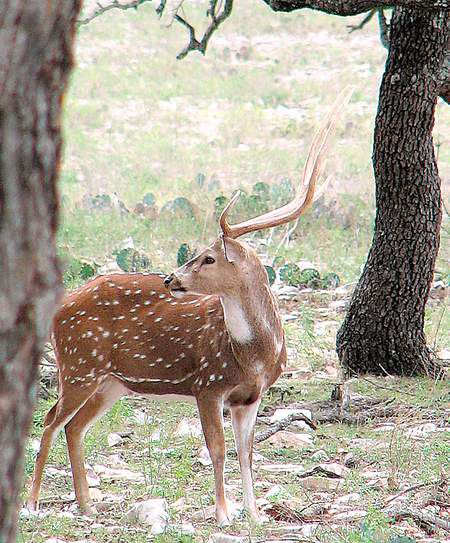Deer hunt in Hawaii
Published 5:00 am Thursday, April 28, 2011

- Axis deer were given as a gift to King Kamehameha V in 1867. They have thrived on the Hawaiian islands of Lanai, Molokai and Maui. They can also be hunted in Texas and Florida.
Out the window of the plane, the slopes of the island rose up to meet us; our shadow flashed across the ground. A red cinder track cut through the green grass below. Even as I watched, a deer stepped out onto the road and looked up.
There is a culture of the hunt in Hawaii, glimpsed in towns away from the beachfront. The head of a mouflon ram hangs on a barn, deer heads adorn the walls of the grocery and cast axis deer antlers hang from fence rails.
Larry and Tara Grassman, of Christmas Valley, had arrived the evening before. We would hunt with my friend Pat Fisher, of Hawaii Safaris. When they picked me up at the airport, Larry showed me a beautiful buck with main beams that stretched the tape to 29 1/2 inches.
By late afternoon, we were back in the field. Tara would hunt with Lanai resident Steve Gelakoski, while Pat and I pushed our way through the tall grass in the Palawai Basin.
At the fence line, Pat handed me his rifle, a Remington 700, chambered for 270 Winchester. “Last year, the grass was shin-high,” he whispered. “Now the guinea grass is 7 feet tall.” It bent with the breeze that blew off the Pacific.
There was salt on the wind, but another scent as well. Deer? There couldn’t be so many deer that I would smell them from hundreds of yards away. Could there?
Over the past three years, my sense of smell had gone away. Now it had been 370 days since my operation with Dr. Ryan Gallivan in Bend. I don’t take it for granted anymore.
A wide swath had been cut through the grass. We walked the edge, then stopped to watch the slopes where, Fisher said, the deer liked to bed.
Axis deer were brought to the islands in the 1860s, a gift to King Kamehameha. The white-spotted deer, with no tigers to keep them in control, have thrived.
The first deer, a doe, stopped at the edge of the grass, halting, nervous. Two fawns, two weeks old, followed her out. The farther we walked, the more deer we saw, does, fawns, young bucks in velvet.
After 500 yards, we topped out on a grassy rise to glass the slopes to the south and east and the flats to the north. I had taken trophy axis bucks before. This time we looked for freak-horns and culls, deer with poor genetics to remove from the herd.
From our vantage, the deer were visible when they would lift their heads, or walk over a hummock to disappear again in the tall grass. I counted. Thirty-one, thirty-two …
The deer scent was strong. Does bleated, bucks grunted, bugles drifted on the wind. Many bucks were in velvet; others were hard-horned. We saw bachelor herds of six or more. Their antlers were three-point in configuration, with brow tines like elk, lyre-shaped main beams and forks at the top, perfect in symmetry. Sixty-five, sixty-six …
I checked the horizon. With my arm outstretched, I could put two fingers below the sun — 20 minutes till dark.
We stalked through grass higher than our heads, slow and quiet. This guinea grass was the reason these deer were here. A sweet grass, I tasted it in the air, a scent like guava.
A deer barked and another took up the chorus. They were close, hidden.
Seventy-seven, seventy-eight … We could see four bucks, perfect specimens, their coats golden with white spots. There, more does. I glanced toward the sun. We had little time left before dark. There was a small buck, perhaps he was the one. Nope, perfect forks. How about that big buck? When he turned his head, we could see 3-inch forks.
Not much light left. A group of does plowed through the grass and emerged in an opening. Eighty-eight, eighty-nine, ninety. The last was a buck with an antler on one side, typical axis, but the other shorter, malformed.
Now, with the Leupold dialed to nine-power, I waited for a doe to move away. The buck was quartered to me. The doe took a step. I squeezed and registered the hit and saw deer running this way and that.
The buck yielded 50 pounds of meat to chill in the cooler. In the morning, we glassed for deer, while two miles away, Gelakoski and Tara stalked axis in the grass.
We heard the shot when Tara’s Nosler AccuBond connected. A few minutes later, we admired her animal, hard-horned and scarred by fighting.
Along the water that night in Honolulu, the ocean breeze sighed in the coconut palms. Waves pounded on the beach at Diamond Head.
In Waikiki, the night life had started. To the tourists in the clubs, this is Hawaii, a state of mind of their own manufacture. There is another side to island life, closer to the land, one the hunter knows when he hears the bugle of an axis buck and smells deer in the long grass.





